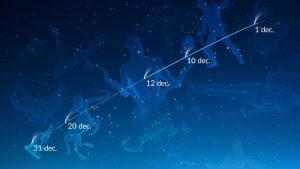In general, your chances of seeing the comet get better if you find a dark area away from bright city lights or street lights. Experts from the University of Arizona say you also have a better shot at catching a glimpse if you look “very low above the horizon just after sunset.”
Lada says that “it will become dimmer and dimmer heading into the final days of December.”
You are missing a once-in-a-lifetime opportunity if you don’t view Leonard this week. The comet won’t be back in our universe for another 80,000 years.

Ursids Meteor Shower peak this week
NASA explains that comets are actually “cosmic snowballs of frozen gases, rock and dust that orbit the sun.”
“When a comet’s orbit brings it close to the sun, it heats up and spews dust and gases into a giant glowing head larger than most planets,” the space agency describes the process.
“The dust and gases form a tail that stretches away from the sun for millions of miles.”
Although the Christmas star only comes around once this week will have some awesome meteor showers.





